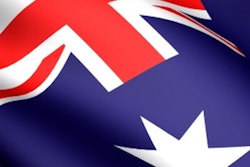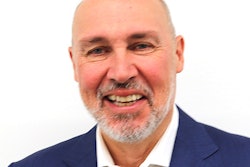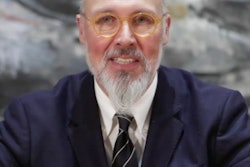
A deep dive into a new life on the other side of the world is always going to be high risk. But anyone hoping that Prof. Paul Parizel, PhD, would fail by the Indian Ocean after leaving the heartlands of European radiology for Western Australia in September 2019 will be bitterly disappointed.
"Some people predicted that I would fall flat on my face and have kangaroos walk all over me! Fortunately, it hasn't happened yet," he said, half-smiling.
 "I like the ocean," says Parizel. All photos courtesy of Prof. Paul Parizel, PhD.
"I like the ocean," says Parizel. All photos courtesy of Prof. Paul Parizel, PhD.Two and a half years on, the past president of the European Society of Radiology (ESR) is doing rather well in Perth.
Perth is known as the world's most isolated city, being located nearly 3,300 km from Sydney on the other side of the outback, but Parizel does not appear to be a lonely or marooned individual. More than that, he seems extremely happy.
"I like the ocean; I like to dive into the waves and feel the salty water on my skin. But my activity would probably be closer to floating than swimming!" he told AuntMinnieEurope.com in a Zoom interview in April.
While he is relishing the challenge of a substantial clinical/academic role at the Royal Perth Hospital (RPH) and University of Western Australia (UWA), he keeps a mature and wary eye on the perils of a life of sunshine and surf. RPH is home to a state Spinal Injuries Unit, a tertiary referral center that sees many water-related spinal injuries among people who misread the sea's depths, dumping surf, and currents.
No cultural desert
There were some in Europe who wondered not just about his mental health but also his judgment when he set out for what they ignorantly called a cultural desert, according to Parizel. But Perth is "by no means an intellectual backwater" and its cultural offerings evidently suit the sociable Belgian as much as the state's climate and sparkling beaches.
The vibrant metropolitan hub boasts two symphony orchestras and the "fantastic" Western Australia Ballet Company (WABC), the country's oldest, which remained operational throughout the COVID-19 pandemic.
"The artistic director is from Mons, Belgium, and the CEO is from Paris; I know them both, and I have seen all their performances," he said.
 Parizel meets Peter Roaen, Honorary Consul of Belgium in Western Australia, at the reception after the opening night of Dracula, a ballet created by the Western Australia Ballet Company.
Parizel meets Peter Roaen, Honorary Consul of Belgium in Western Australia, at the reception after the opening night of Dracula, a ballet created by the Western Australia Ballet Company.Add to that a sumptuous university campus that draws high-quality students from around the world, and Parizel says he feels "incredibly lucky to have been made welcome in a very short time by so many friends and colleagues in this amazing place".
It sounds like it more than matches up to his old life.
Also, anyone who denies Perth has a rich medical heritage needs to look at RPH, one of the oldest hospitals in Australia. "Interestingly, in 1830, the first patients were treated in tents, and recently, during the pandemic, a tent construction was built in front of the hospital to screen and accommodate potentially infected patients. History has come full circle!" he remarked.
It's important to remember Drs. Barry Marshall and John Robin Warren from the UWA received the 2005 Nobel Prize in Medicine for their discovery of the bacterium Helicobacter Pylori as the cause of stomach ulcers, he added.
The switch from Europe
Parizel is a past president of the European Society of Neuroradiology (ESNR) and Belgian Society of Radiology (BSR) and was president of the ESR in 2017. For over 15 years, he was chair of radiology at Antwerp University Hospital (UZA) and professor of radiology at the University of Antwerp (UA). He ran a large department with 23 radiologists and over 70 radiographers and nurses performing and reading close to 500 procedures per day, and he coordinated the radiology residents-in-training program.
Does he still run a department like that? "No, thank god," he said.
At the UWA, he holds the David Hartley Chair of radiology, and he is director of the WA node of the Australian National Imaging Facility (NIF) funded by the federal government. The NIF is a 300-million-Australian-dollar (202.5-million-euro) scientific platform that provides imaging capability for all researchers, including those conducting animal and plant studies.
Parizel said he was told prior to his arrival that the state's lack of access to top-class imaging facilities meant it was "hemorrhaging" around 10 million to 15 million Australian dollars (6.7 million euros to 10 million euros) of research money to institutions elsewhere. He now leads the development and expansion of the human imaging capability at UWA, which will be "a research-only 3 tesla MRI and a research-only PET-CT".
"We hope we will now be able to keep some of that intellectual activity and also some of that money within the state," he pointed out.
Building a research and clinical hub
The WA NIF facility aims to plug a gap in Western Australia, by providing access to dedicated research imaging equipment -- such as preclinical and human MRI, CT and micro-CT, PET-CT, bioluminescence -- across a wide range of applications, including human imaging, molecular imaging and radiochemistry, plus imaging of animals, plants, and materials.
A unique feature of the WA NIF is the co-location of radiology, nuclear medicine, and radiopharmaceuticals in one research facility; the NIF-motto, "Because seeing changes everything," sums it all up, according to Parizel.
"We will be offering a research-only full option facility and hope to serve the community that is leading clinical trials to provide quantitative reproducible standardized imaging for patients enrolled in clinical trials," he explained.
He said the project has been "occupying most of my waking hours -- and some of my nightmares as well" because he has been involved in various contract negotiations and siting decisions.
The Western Australia node of the NIF will have a full complement of six fellows, four of whom are now on board and one of whom hails from the U.K. Parizel said this shows the pulling power of UWA and its ability to attract high-quality students and staff.
 Parizel hands over an award to Dr. Kyle Raubenheimer, a junior medical officer at RPH, in recognition of his excellent communication skills in requesting and motivating radiological examinations.
Parizel hands over an award to Dr. Kyle Raubenheimer, a junior medical officer at RPH, in recognition of his excellent communication skills in requesting and motivating radiological examinations.UWA ranks among the top 100 universities in the world and sits in the top 50 for clinical medicine. It draws many students from countries and regions including Asia, South-East Asia, Middle East, and the Indian Ocean Basin.
Parizel says a more recent "smaller but fun" venture at the RPH has involved joining up in a national project initiated by Monash University, Melbourne, and the South Australian Health and Medical Research Institute, Adelaide, to operate a mobile, head-only MRI scanner "so that we can bring the MRI machine to the patient bedside, rather than the other way around."
"Our machine is scheduled to arrive in a few months, which is quite exciting," he said, adding that the scanner operates at a field strength of 0.064 tesla and is about the size of an ultrasound machine (140 cm high and weighing 630 kg).
"It can be plugged into a regular power outlet," he continued. "The objective of the project is to establish a new capability of point-of-care MRI with improved image quality and clinical utility, particularly in stroke and brain injury patients."
Travel bans and red tape
It's a good thing Parizel has adjusted well to Perth because he has effectively been stuck there since March 2020, thanks to COVID-19, when Western Australia "basically closed its borders" to travelers and imposed strict quarantines.
Compared with many other places, it has seen comparatively small SARS-CoV-19 case numbers and minimal community transmission of the virus, meaning citizens have lived their lives "almost as normal" with relatively modest restrictions, he explained.
But it has come at the personal cost of Parizel being unable to host his 34-year-old son, a medic in Antwerp, for over two years in his new home. And as an essential healthcare worker, Paul Parizel is for the time being still not allowed to take overseas leave, so his attendance at major international conferences this summer remains in doubt.
Have there been any other lows during his time Down Under?
"Red tape," said Parizel. "The word on the street is that the British invented red tape but the Australians perfected it."
Red tape can have the effect of slowing down some undertakings, but overall, he admires the character of his new compatriots, including their healthy sense of national pride.
 Parizel remains keen to build bridges between Australia and Europe.
Parizel remains keen to build bridges between Australia and Europe.Parizel is still closely linked with the ESR and is trying to "build links to continental Europe," although he says Australia still pulls more towards the U.K. and Commonwealth countries.
Evolution of imaging
In terms of work, Parizel seems busier than ever. In addition to his other roles, he is still involved in research. He is a principal or co-investigator on several pending research grants and has been writing papers with hospital colleagues.
"A common thread throughout my current activities is the transmogrification of imaging towards so-called big data," he said.
In radiology, the bulk of the workload is shifting towards using imaging in the management and follow-up of patients, assessment of treatment efficacy and complications, quantitative assessment of lesion volumes, etc.
"In other words, in many cases the diagnosis has already been established, but imaging is used to "see" the evolution under therapy. This implies that imaging is no longer about producing images, but it has become big data. Extracting features from medical images using data-characterization algorithms is now known as radiomics," he explained.
Standardization and reproducibility of image acquisitions, data analysis software, and data management tools are dominant themes for Parizel.
"This is not new for me, since my interest was already reflected in the PhD projects I supported while I was in Antwerp," he said. "Perhaps this sounds rather ambitious, and perhaps even arrogant, but moving from images to data science is simply the direction in which imaging science is evolving," he said.
Community feel
Overall, Parizel has found there to be "more of a community feel here." He enjoys the emphasis on outdoor socializing, compared with Belgium, where he says people seem "more private" and tend to retreat behind closed doors. He says it wouldn't surprise him to find other radiologists risking a move to Australia.
"With the way Western Australia has managed the pandemic -- and with a de facto war going on in Europe -- it seems for a lot of people, the most isolated city on earth with the most beautiful climate and the cleanest ocean you've ever seen has suddenly become very attractive," he said.



















